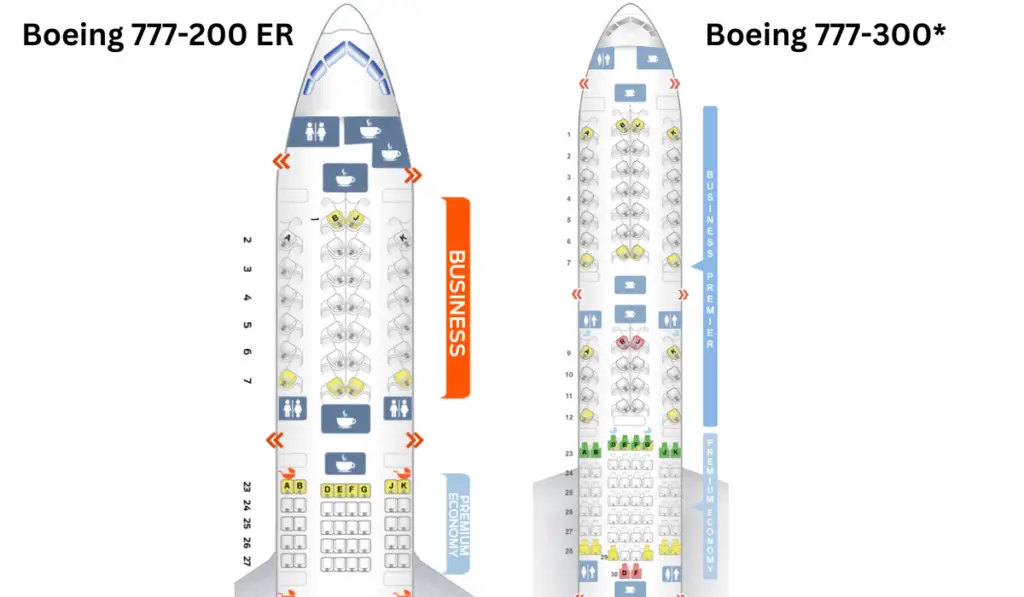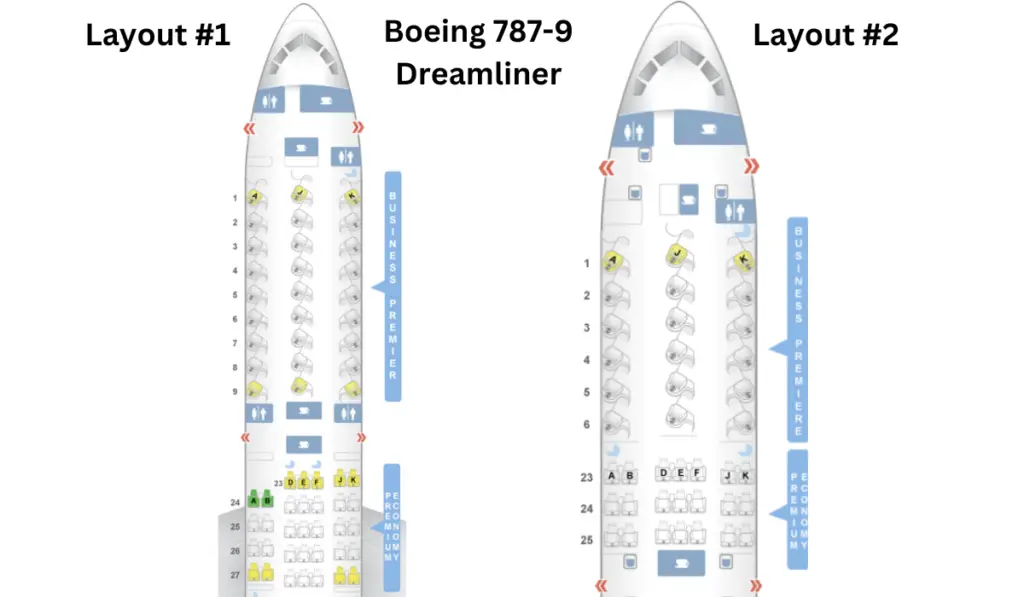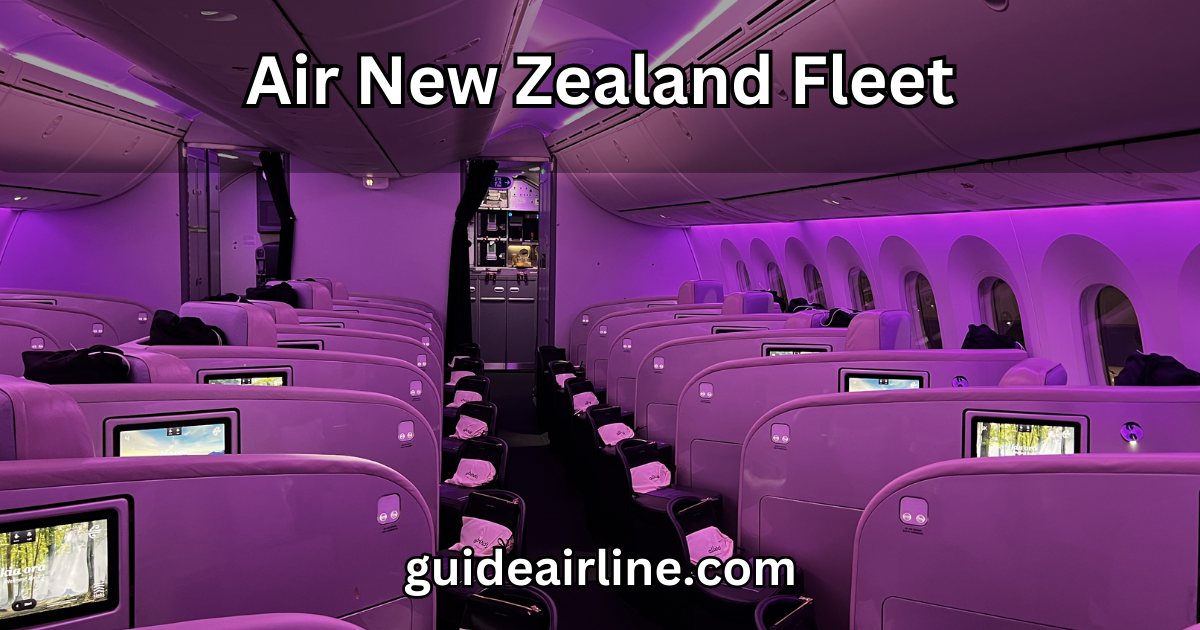This topic will focus on the Air New Zealand fleet, mostly pointing out their two largest aircraft, the Boeing 777 and Boeing 787. These widebody jets hold significant importance as they are the primary fleet operated by the airline. Particularly noteworthy is the attention given to their business class offerings, where passengers are treated to lie-flat seats for a premium travel experience.
Boeing 777
Air New Zealand operates the Boeing 777 as a significant part of its long-haul fleet. The Boeing 777 is a twin-engine wide-body passenger airliner known for its fuel economy, extended range and spacious cabin design.
Air New Zealand’s Boeing 777 fleet includes the Boeing 777-200ER and Boeing 777-300ER and other models with an average age of 10 years, providing passengers with a comfortable travel experience on intercontinental and international routes. With state-of-the-art facilities, advanced in-flight entertainment systems and comfortable seating configurations, the Boeing 777 plays an important role in ensuring a comfortable journey for passengers on Air New Zealand’s long-haul flights.

*Note: Seats 9B and 9J in Business class as well as 30D and 30F in Premium economy class might be bothersome. Mentioned Business class seats face the lavatory and Premium economy seats are located just between both lavatories in the cabin.
Boeing 787
Air New Zealand’s Boeing 787 Dreamliner is a revolutionary aircraft that offers passengers a first class and technologically advanced travel experience. The Boeing 787 is known for its fuel efficiency, reduced carbon emissions and supports Air New Zealand’s commitment to sustainability. With a spacious and modern interior, improved cabin pressure and larger windows, the Boeing 787, with an average age of 6 years, ensures that long-haul passengers have more comfortable and relaxing journeys.
The Boeing 787 is equipped with the latest in-flight entertainment and options, reflecting Air New Zealand’s commitment to providing passengers with an outstanding and enjoyable in-flight experience.

Air New Zealand 787 business class
Air New Zealand Premium economy 787-9 review
Air New Zealand economy class 787-9
Conclusion
In conclusion, Air New Zealand’s fleet represents a diverse and modern collection of aircraft, enabling the airline to cater to various routes and passenger preferences. With a focus on safety, efficiency, and passenger comfort, the airline regularly updates its fleet to stay at the forefront of aviation technology.
Whether it’s short-haul regional flights or long-haul international journeys, Air New Zealand continues to deliver exceptional in-flight experiences to travelers worldwide. As the airline embraces advancements in aviation, passengers can expect an even more seamless and enjoyable journey in the years to come.
FAQs
How many aircraft are there in Air New Zealand’s fleet?
Air New Zealand’s fleet comprised around 105 aircraft. However, please note that fleet sizes can change over time due to additions, retirements, or changes in the airline’s operations.
What types of aircraft are included in Air New Zealand’s fleet?
Air New Zealand’s fleet included a variety of aircraft types. Some of the main aircraft types in their fleet were:
• Airbus A320 Family: Including A320 and A321neo models, used for short to medium-haul flights.
• Boeing 777: Including 777-200ER and 777-300ER models, used for long-haul international routes.
• Boeing 787 Dreamliner: Including 787-9 and 787-10 models, used for long-haul international flights.
• ATR 72: Used for regional and domestic routes.
Please note that airlines may update their fleet and retire or introduce new aircraft over time.
How often does Air New Zealand update its fleet?
Air New Zealand typically updates its fleet periodically to ensure the introduction of newer, more efficient, and technologically advanced aircraft. The frequency of fleet updates can vary depending on factors such as market demand, aircraft performance, fuel efficiency, and the airline’s financial position.
Airlines often enter into agreements with aircraft manufacturers for scheduled deliveries of new planes over several years. For instance, Air New Zealand might have made orders for new aircraft that are scheduled to be delivered over a specific period.
It is essential to note that fleet updates are a continuous process for most airlines, as they seek to modernize their operations and offer improved passenger experiences.
What is the average age of Air New Zealand’s fleet?
The average age of Air New Zealand’s fleet is around 9.5 years. However, airlines continuously update their fleet by retiring older aircraft and adding new ones.
How many different seating classes are offered across the fleet?
Air New Zealand typically offers three different seating classes across its fleet:
• Economy Class: The standard class with comfortable seating, in-flight entertainment, and a range of meal options.
• Premium Economy Class: A higher level of comfort and amenities compared to Economy Class, including larger seats, enhanced meal services, and priority boarding.
• Business Premier Class: The premium cabin with lie-flat beds, exclusive dining options, dedicated lounges, and personalized service.
How does Air New Zealand maintain and ensure the safety of its fleet?
Air New Zealand places a strong emphasis on safety and implements rigorous maintenance and safety measures to ensure the well-being of its fleet. Here are some key aspects of how the airline maintains and ensures the safety of its aircraft:
• Regular Maintenance Checks: Air New Zealand adheres to strict maintenance schedules for its aircraft. Routine checks are conducted as per manufacturer recommendations and regulatory requirements. These checks involve inspecting various components, systems, and structures to identify and address any potential issues.
• Highly Skilled Maintenance Crew: The airline employs highly trained and certified maintenance technicians and engineers responsible for the upkeep of its fleet. They undergo continuous training to stay updated on the latest aviation technologies and practices.
• Compliance with Regulations: Air New Zealand adheres to stringent aviation regulations set by governing bodies such as the Civil Aviation Authority of New Zealand (CAA) and the Federal Aviation Administration (FAA) in the United States. These regulations govern safety standards, maintenance procedures, and operational practices.
• Safety Management System (SMS): The airline has a robust Safety Management System in place to proactively identify and manage safety risks. The SMS involves reporting and analyzing safety-related incidents and implementing corrective actions to prevent future occurrences.
• Quality Assurance Programs: Air New Zealand implements quality assurance programs to assess and ensure the effectiveness of its safety practices and procedures.
• Continuous Monitoring: The airline continuously monitors its fleet’s performance and conducts regular audits to maintain safety standards.
• Pilot Training and Safety Culture: Air New Zealand places significant importance on pilot training and fosters a strong safety culture among its flight crew. Pilots undergo recurrent training to handle various scenarios, including emergency situations.
• Aircraft Upgrades: The airline invests in modernizing its fleet by introducing newer aircraft with advanced safety features and improved fuel efficiency.
Overall, Air New Zealand’s commitment to safety is a top priority, and it continuously seeks to enhance its safety practices and ensure the highest level of security for its passengers and crew.
Welcome! I’m an aviation expert with 9 years of experience. Let me share valuable insights and solutions in this dynamic field. Enjoy my blog!

